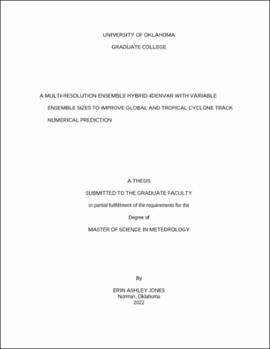| dc.description.abstract | One challenge associated with ensemble-based data assimilation (DA) is the quantitative estimation of the background error covariances. In the current global operational DA system, a reduced resolution background ensemble is adopted, which restricts the ensemble background error covariance from resolving a wide range of scales. A recent study developed a multi-resolution ensemble four-dimensional ensemble-variational (4DEnVar) method and determined that this approach can provide a nearly comparable analysis and forecast to a single high-resolution ensemble approach with the same ensemble size, while substantially lowering the computational cost. This study further develops the multi-resolution ensemble 4DEnVar approach to allow for a flexible number of low- and high-resolution ensemble members as well as different localization length scales between the high- and low-resolution ensembles. The goal of such development is to determine a more effective way of sampling large and small scales to formulate a method aimed at achieving an effective multiscale DA system.
Utilizing the Finite-Volume Cubed Sphere Global Forecast System (FV3GFS), three 4DEnVar experiments with the same computational costs are compared. The first has an 80-member high-resolution background ensemble with single-scale localization. The second and third utilize the multi-resolution ensemble developments. One has a 170-member multi-resolution background ensemble, including 130 low-resolution and 40 high-resolution members. The other has a 204-member multi-resolution background ensemble with 180 low-resolution and 24 high-resolution members. Both multi-resolution ensemble experiments also utilize scale-aware localization radii. Despite having the same costs, the multi-resolution ensemble method decreases tropical cyclone track errors and improves global forecasts for up to five days in lead time. Diagnostics suggest that the multi-resolution ensemble method demonstrates improvement in analyzing large-scale features. At early lead times, improvements are most apparent in the upper levels in the tropics, while at later lead times, the Southern Hemisphere extratropics demonstrates greater improvement. The reduction of forecast errors in the extratropics at later lead times is partially due to improved analyses of large-scale features in the tropics that shift poleward. With regard to tropical cyclone track errors, the multi-resolution ensemble method can more properly correct the large-scale steering flow, leading to more accurate subsequent track forecasts. Additionally, the multi-resolution ensemble with a greater number of high-resolution members performs better than the multi-resolution ensemble with a greater number of low-resolution members in most metrics, demonstrating the value of both increasing sampling at large scales and retaining substantial information at small scales. | en_US |
